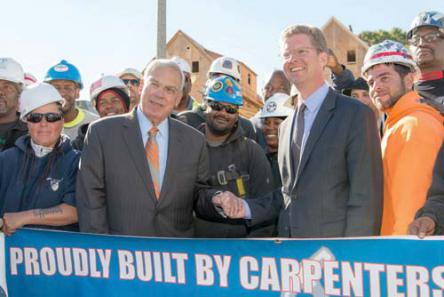October 31, 2013
 Quincy Street: Mayor Thomas Menino joined U.S. Housing Secretary Shaun Donovan outside of 196 Quincy Street last Thursday. Photo by Travis Watson
Quincy Street: Mayor Thomas Menino joined U.S. Housing Secretary Shaun Donovan outside of 196 Quincy Street last Thursday. Photo by Travis Watson
Federal and city officials last week highlighted the start of the Quincy Street corridor’s sweeping overhaul with Mayor Thomas Menino joining US Housing Secretary Shaun Donovan outside of 196 Quincy St., a former meat processing facility that once housed hot dogs and cured meats. City officials hope the 36,000-square foot space will become a place where local food producers can share storage space and a common kitchen.
The corridor will be receiving $100 million investment from various sources, including a $20.5 million grant from the US Department of Housing and Urban Development. The overhaul will lead to 129 redeveloped housing units.
The grant includes $12.3 million to redevelop the nine-building Woodledge/Morrant Bay housing development, which will be renamed Quincy Heights; $3.1 million for economic development and parks and gardens, and $3.1 million for support services for Quincy Heights residents and others living in the corridor, which is dominated by low-income families.
“Within about two years we’re going to see a completely different street, between Columbia Road and Blue Hill Ave.,” said Jeanne Dubois, executive director of the Dorchester Bay Economic Development Corporation, one of the organizations driving the changes to the corridor.
The Quincy Corridor is a four-to-five block area near Grove Hall that has a 40 percent unemployment rate, according to Dubois. “For years, it’s been very distressed and underdeveloped and now it’s going to be a real magnet,” she said. “When construction is done, city will redo the sidewalks, and add benches and trees.”
The food production center is expected to open next April, while the project’s housing portion will likely be done by next December, Dubois said.
According to Dorchester Bay, since construction started in July, minority-owned businesses have received 40 percent of the work with 60 percent of workers being people of color.
Separately, a former auto repair shop at the corner of Ceylon and Quincy streets could be turned into a jobs and skills center for 3-D printing, she said. Her organization is still exploring the feasibility of such a set-up.
The Local Initiatives Support Corporation (LISC) is also involved in and providing funding for the Pearl Food Center and Quincy Heights. The Dudley Street Neighborhood Initiative, the Quincy-Geneva Community Development Corporation, and Project RIGHT, a Grove Hall-based anti-violence group, are three other organizations that are collaborating with Dorchester Bay on the project.
“LISC is proud to have partnered with Mayor Tom Menino, Secretary Donovan, and the Dorchester Bay EDC in this important Choice Neighborhood Revitalization effort, bringing private capital for both the Choice housing and for the Pearl & Bornstein Food Production Small Business Center,” its president, Michael Rubinger, said in a statement.
“Working with our community partners, we will together make Quincy Street more than just a street in our city – it will become an avenue for an entire community to reach economic prosperity,” Menino said in his own statement.


